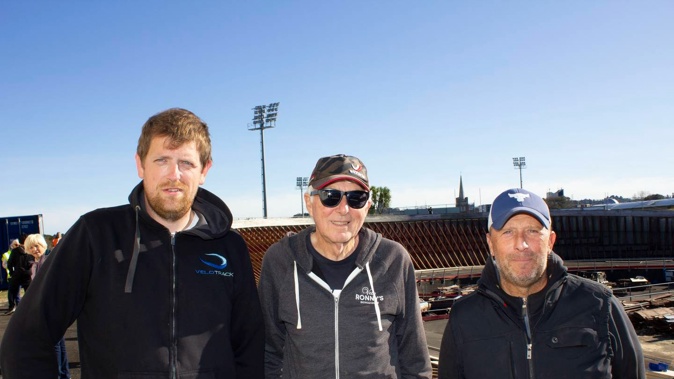
Whanganui’s Velodrome is undergoing a $2.5 million track reinstatement by German company Velotrack, the most experienced and successful Velodrome builder in the world.
It’s the fourth track they’ve built, with others in Austria, Egypt, and Tel Aviv, with an expected completion date in about two months.
The company is owned by Walter Von Luetcken and his son Sebastian, who is out here running the job, with the managing director coming out soon. The subcontractor to Velotrack, working on the project, is Peter Jacques, who has a stellar cycling career.
Born in Leeds in England, Peter is a 10-time British Cycling Champion with three Omnium titles, two Keirin titles, and five Team Sprint titles and he won the World Cup in Athens. He has won five national league titles as well.
“In team GB in the lead-up to the Olympics in Sydney, I got a contract to go to Japan for the professional Keirin Series,” he said. “I gave up my place on the team for the Olympics to go to Japan. For me, that was the pinnacle of my bike riding career.
“As an ex-cyclist, I’m able to bring an athlete’s point-of-view to the track designs, the way the tracks are set up, and the surfaces to use. I’m also a trained carpenter - my parents made me get a trade, just in case I wasn’t any good on a bike, but it came in handy because I’ve gone back onto the tools and put my trade to use.
“There’s a team of seven carpenters here - two from Poland, one from Austria, three from Germany, and myself (now living in Scotland), like a multi-European team, with others coming in. We had a delay with work visas, which means we’ve overlapped with other projects.
“We’ve all had experience in Velodrome building. Owing to our experience, we can spot problems before they arise.
“The original track was built well by Ron Webb, using a Malaysian hardwood, which could splinter if a cyclist crashed, because of the way the grain goes.
“The timber Velotrack is using is an engineered material, Accoya, developed in Holland using New Zealand-sourced pine, which is shipped to Holland and returned.
“They take away everything that can be affected by the weather - starches, sugars, water, and anything that can be eaten by termites. It’s then reinjected with a vinegar-like acid, which makes it impervious to water, giving it a 50-year life outdoors. It’s used for lock gates and bridges in Holland,” he said.
The original track surface has been stripped off, with carpenters careful not to pull the trusses out of position and repairing if necessary as they build. The hand nail system they are using allows for compact joints, which will use over 300,000 nails, end-to-end the timber would measure 75km.
“Some records had been set on the track in the past, but this rebuilt track will be faster,” said Peter. “To be fair, the riders are also faster.
“The surface is attractive with a nice bright colour, it’s easier to focus on other riders, because they stand out more,” he said.
Rosemary Fletcher, manager of Capital Works, for Whanganui District Council, said this is a council project, providing $2.5 million for track reinstatement.
“We’ve been very lucky the Whanganui Cycling Club, and Ron Cheatley, their patron, have opened their clubrooms to contractors on site,” she said. “We’re really grateful for that and local suppliers have been brilliant.”
This asset is viable for Whanganui long-term, with a 50-year lifetime, with the whole community having access to this it.
/cloudfront-ap-southeast-2.images.arcpublishing.com/nzme/JMDIE7UB6RDRBAXP24JBKXMM5U.JPG)
Ron Cheatley is patron of Whanganui Cycling Club, twice Halberg NZ Coach of the Year, and was on the Cook’s Gardens Trust when Russell Sears (Whanganui Athletic Club) wanted to turn the main Cook’s Gardens Arena into an all-weather athletic track, which was just grass then.
“Around the outside was the cycling track,” said Ron. “For them to do that successfully, we needed to get a cycling track built first. When the survey was done, in a big sand hill area under the clock tower, we found that we could build a 250-metre facility - the international standard size.
“It was the first wooden track in New Zealand, now there are three. It was a breakthrough for New Zealand Cycling to build the Whanganui track in those days.
“They built the track, then they put down the all-weather running track, which made it an international-class sporting arena. I don’t think Whanganui people appreciate how unique it is, that we have this great sporting facility, for athletics, cycling, rugby, and more, adjacent to the main street - you don’t get that anywhere in the world. If we ever get to the stage where we can put a cover over it, that would just be fantastic.
“When we first built the Velodrome, I was the National Track Cycling coach, I’d been the National Road Cycling coach prior to that, all up, for 20 years.
“All the training camps were here - National Championships, Olympic team, and World Championships team training camps, to name some. It was home to all the top cyclists in New Zealand until the two indoor tracks were built,” he said.
As a cyclist, Ron started on the track in 1962 and rode all the big events, with a passion for the sport.
“It’s been a big part of my life, for over 60 years,” he said.
Ron used to manage the General Machine Company Ltd, with five branches in New Zealand, for engineering products. He also had a photographic division with top brands like Hasselblad and Bolex - the company was the New Zealand importer.
“As I was general manager of the company, I found that it was a difficult area, we needed more expertise in that division to make it even more successful.
“I sold those two agencies to an Australian company and with the funds, started a cycle wholesale/import company, Cycle Sport New Zealand. I knew a lot about cycle products, where to get them, and that business just grew.
“We became the New Zealand importer for Trek bicycles, then later on we opened up the retail shop - Velo Ronny’s Bicycle Store,” he said.
The company is now owned by Ron’s youngest son Dayle, and his wife, Cath.
Take your Radio, Podcasts and Music with you









